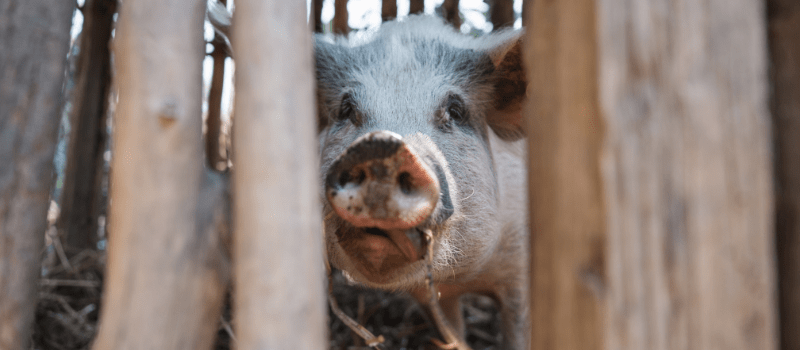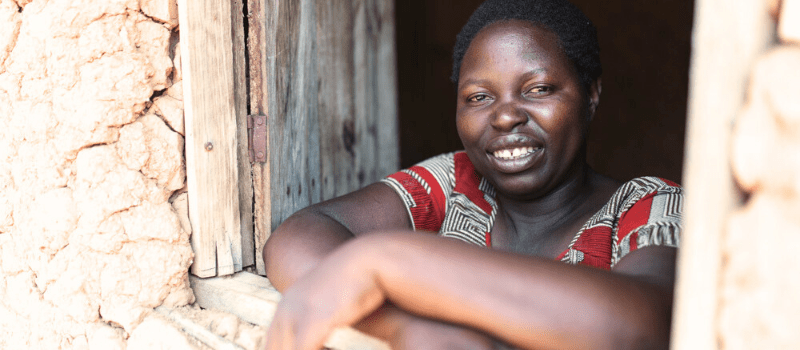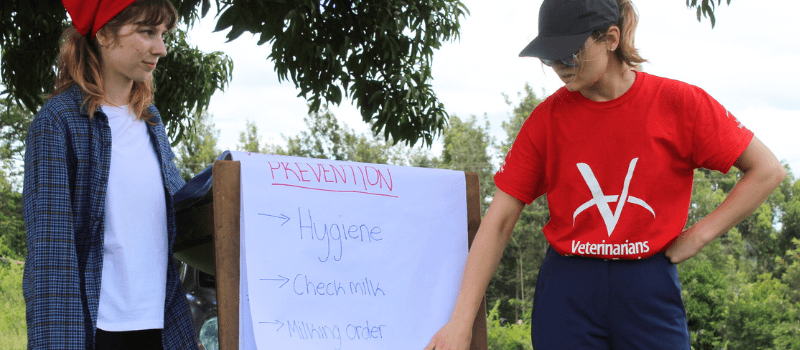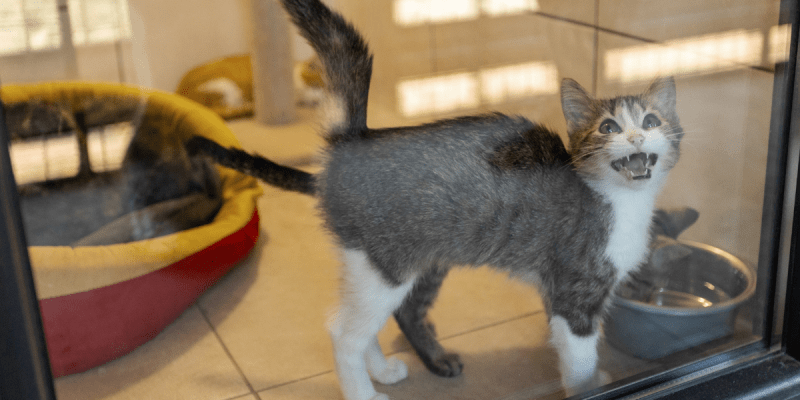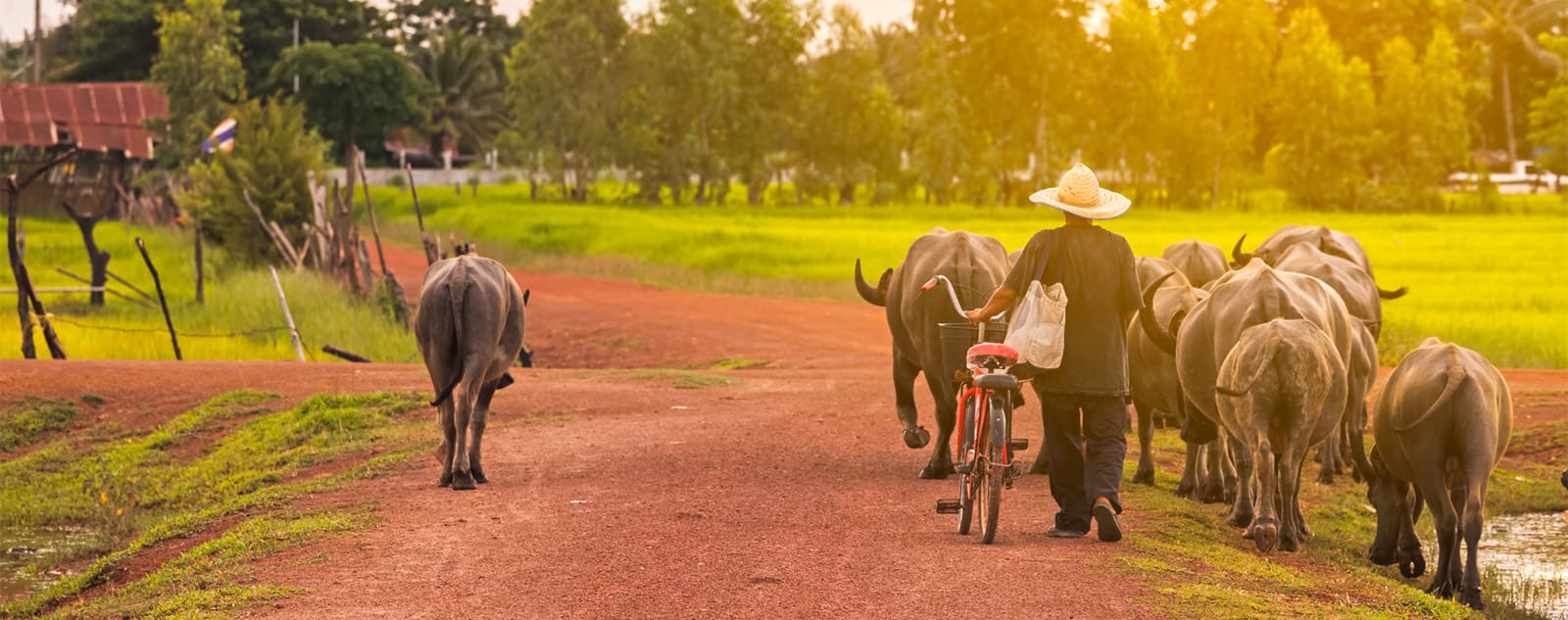This blog was written by Tanja Kisslinger, Director of Communications at VWB, in reflection of a trip to Rwanda in September 2025 to document our Community One Health Empowerment in Rwanda and Senegal (COHERS) program. Photos by Jess Holing for VWB.
Louise and the Links Between Lives
Surrounded by the lush hillside of Tare Sector, I met Louise Mukarugwiza in the rising heat of morning — it was already another routinely busy day for her as a mother of six, a long-time Community Health Worker (CHW), and a dedicated One Health Team member (OHT). Her shy smile was the first thing I noticed — the second was the grey vest she wore proudly over her dress, marking her role as an OHT member. It was a symbolic layering of duty, knowledge, and responsibility that she took to with characteristic determination.
Louise's homestead was modest — a courtyard swept clean, a few children darting in and out from behind her legs, and her husband nearby with their youngest in his arms, observing the visit with keen interest. As she walked me over to her chicken coop, speaking about the pig she lost to illness a year ago, we passed the family's new latrine and paused beside it. “When this project began, I thought my job was to care for people,” she said. “But now, I see the lines between people and pigs, soil and illness. The work we do connects all of that.”
That quiet moment became my compass for the week. I would soon learn that it’s through the everyday actions of women like Louise that COHERS in Rwanda is taking shape — not as an abstract program, but as a lived movement built on collaboration and care.
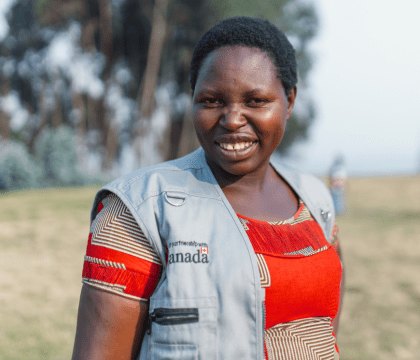
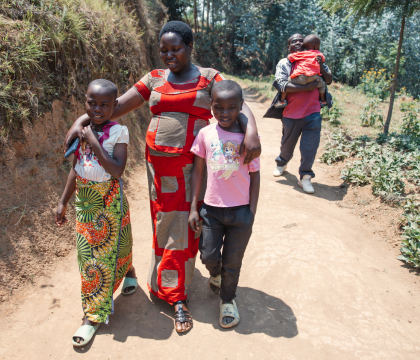
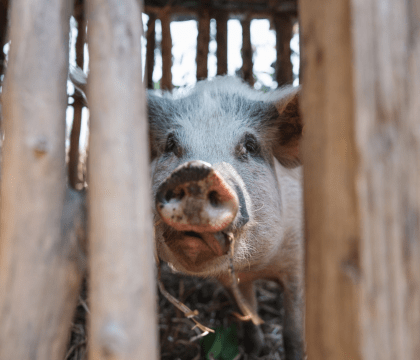
Introducing COHERS in Rwanda
COHERS — Community One Health Empowerment in Rwanda and Senegal — is ambitious in both scope and vision. Operating across two countries, the project aims to prevent zoonotic disease by weaving together human, animal, and environmental health interventions, while also strengthening local systems and generating research that can carry this work forward and scale it.
In Rwanda, COHERS focuses on Taenia solium, the pork tapeworm — a silent parasite that crosses species and landscapes. When pigs ingest parasite eggs from contaminated soil or human waste, they develop cysts in their muscle tissue. People who eat undercooked pork risk intestinal infection (taeniasis). More dangerously, humans who ingest the eggs directly can develop cysticercosis, including neurocysticercosis — a serious condition where cysts form in the brain, leading to seizures, memory loss, and lifelong disability.
This isn’t just a veterinary issue. It’s a classic One Health challenge — one that thrives where sanitation systems are weak, pigs roam freely, and public health infrastructure is stretched. In Rwanda, where the pig population has grown to an estimated 1.7 million, pigs are a source of supplemental income, a safety net during lean times, and a source of manure for smallholder crops. But while 94% of Rwandan households report access to improved sanitation, only 72% use toilets that aren’t shared. In rural areas, roughly 1 in 5 people still lack access to basic sanitation altogether.
The risks are not evenly distributed. Women and girls bear the brunt of daily care work — fetching water, cleaning pens, managing household hygiene — and are most often the caregivers when illness strikes. A parasite that moves between pigs and people doesn’t just spread disease; it reinforces cycles of poverty, hunger, and gender inequity.
It is in this context — and in response to these intersecting challenges — that COHERS finds its purpose.
Bridging Disciplines, Breaking Cycles
The challenge of Taenia solium demands more than a single intervention. Treating a child, deworming a pig, or building a latrine in isolation cannot disrupt the cycle. That’s why COHERS was built on One Health principles — bringing together veterinarians, community health workers, gender specialists, and WASH experts to design solutions that reach across sectors and into daily life.
People. In July, more than 4,400 people from 20 villages across Nyamagabe District received praziquantel through mass drug administration — a critical step in reducing the human burden of Taenia solium. These efforts were led by trained and trusted One Health Teams and local leaders who move between households with knowledge and presence.
Animals. At the same time, over 2,500 pigs have been vaccinated with TSOL18 — a vaccine that prevents cyst formation in pigs and breaks the transmission cycle at its animal source. Paravets trained by VWB now vaccinate up to 60 pigs a day, often traveling by motorbike to reach homes tucked between hills. A few moments of restraint, a quick injection, a brief exchange in Kinyarwanda — and a family’s most valuable asset is one step safer.
Environments. COHERS is also constructing 1,000 latrines across three sectors, targeting households that previously had none. Selection criteria prioritized the most vulnerable: female-headed homes, large families, those raising pigs, and those without prior access. To date, 700 are complete. Beside one of them, I met Josephine — a member of her local Community Hygiene Club — who told me, “This is more than a toilet. It’s privacy, dignity, and safety.” Her words stayed with me.
CHCs like Josephine’s do more than promote handwashing — they make sanitation visible and bring once-taboo topics into the open. Conversations are happening about menstruation, open defecation, and the link between a child’s stomach pain and the pit latrine across the path — issues that were once hidden but are now being shared.
And it’s at this intersection — where daily practice meets community dialogue — that the real power of COHERS emerges: the synergy between OHTs and CHCs.
The Power of Partnership: OHTs and CHCs in Motion
More than 250 One Health Team (OHT) members have been trained across Rwanda, bringing together expertise in health, agriculture, water, and sanitation to ensure no link in the One Health chain is overlooked. Many, like Louise, are women already trusted within their communities.
Through home and farm visits, they share practical knowledge that bridges people, pigs, and prevention — helping families improve pig care, hygiene, and shared household responsibilities. The 10-module training has broadened their lens: where once Louise saw only a sick child, she now looks at animal health, sanitation, and workload balance. When one family followed her advice to pen their pigs and improve feed, their smallest pig began to thrive. The science matters — but so does the social proof.
Working alongside these teams are the Community Hygiene Clubs (CHCs). To date, 100 CHC facilitators like Josephine have been trained in Rwanda. In Tare Sector, the CHC meets monthly to share and refresh knowledge using illustrated cards. On a brilliantly hot day in Tare, I watched them laugh and learn together — practicing how to teach households about latrines, manure management, and handwashing. Their enthusiasm was infectious.
Crucially, the synergy between OHTs and CHCs goes beyond education — it builds trust. When CHC members sing about sanitation or perform at community meetings, OHTs are there to answer questions, deepen understanding, and follow up at the household level. Together, they’re not just delivering knowledge; they’re transforming norms.
That same day, I watched an OHT gender skit portray a man coming home drunk, pigs roaming free, and a sick child with worms — followed by the team stepping in to guide the family with empathy and solutions. These aren’t just performances; they’re door-openers for difficult conversations that slowly begin to shift behaviour.
From knowledge to norms, from households to whole communities — this is the foundation on which COHERS’ social and behaviour change strategy is being built.
Where the Message Meets the Masses
If OHTs and CHCs are the daily heartbeat of COHERS, then Social and Behaviour Change Communication (SBCC) events are its amplifier — carrying messages beyond meetings and into the public square.
In Cyanika Sector, I saw this in action. A sunny football pitch had been transformed into a stage, a classroom, and a celebration. Loudspeakers crackled with announcements as two women’s teams faced off in a friendly match. The crowd cheered — and between the goals and laughter came something else: public health messages woven through song, theatre, and dialogue.
The announcer’s voice carried reminders about washing hands with soap, seeking treatment for stomach pain, and keeping pigs penned and well-fed. There were giveaways — soap, jerrycans, washbasins — but the real prize was knowledge. CHC members led demonstrations on food hygiene, water treatment, and menstrual health. One used a cabbage leaf to show how soil particles cling to the outer layers, reminding people to peel and rinse thoroughly.
The Kigeme Hospital Director General stepped forward to speak, naming Taenia solium and neurocysticercosis and explaining the parasite’s journey from pig to plate to brain. People listened — not out of fear, but because the message had been woven into celebration, sport, and song. Children clutched prizes while older women took notes on leaflets. Men, often more difficult to engage, stayed to watch and ask questions.
It was health promotion — but also social theatre, local leadership, and grassroots mobilization. Events like this don’t just raise awareness; they reinforce the foundation already laid by OHTs and CHCs, shifting disease prevention from instruction to inspiration, from information to transformation.
Looking Ahead
There’s no question that momentum is building. Across Rwanda, OHTs and CHCs are active, latrines are rising, pigs are being vaccinated, and more families are learning how a silent parasite moves between species and homes.
But progress doesn’t happen overnight. Behaviour change is gradual — built on trust, habit, and shared understanding. What COHERS has sparked in Rwanda is not a quick fix, but a slow, steady unfolding of knowledge that binds people, animals, and environments together.
Next month, I’ll travel to Senegal, where COHERS is tackling a different disease — anthrax — in a different context. Yet the principles remain the same: local leadership, cross-sector collaboration, and the belief that community-led systems are the most resilient of all.
Closing Reflection
As I left Nyamagabe District and wound my way back toward Kigali, I carried more than notes and photos — I carried a renewed sense of how systems shift when trust takes root. COHERS isn’t simply a project about disease prevention; it’s a story about people, and the quiet, determined work of connection and collaboration that creates lasting health.
The journey continues — and so will the stories.
COHERS is a four-year initiative (2023–2027) that strengthens community health systems to prevent zoonotic diseases in Rwanda and Senegal by uniting human, animal, and environmental health. Funded by Global Affairs Canada and led by VWB, COHERS is delivered with local and international partners including the University of Global Health Equity, WaterAid Rwanda, the University of Guelph, the Institute of Health Economics, and Agronomes et Vétérinaires Sans Frontières. Learn more.

